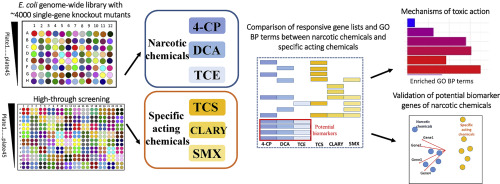Environmental Pollution ( IF 8.9 ) Pub Date : 2017-09-20 , DOI: 10.1016/j.envpol.2017.09.027 Miao Guan , Wendi Fang , Sana Ullah , Xiaowei Zhang , Quaiser Saquib , Abdulaziz A. Al-Khedhairy

|
The knowledge of gene-chemical interaction can be used to derive toxicological mechanism of chemical pollutants, therefore, it might be useful to discriminate chemicals with different mechanisms. In this study, three narcotic chemicals (4-chlorophenol (4-CP), 3, 4-dichloroaniline (DCA) and 2, 2, 2-trichloroethanol (TCE)) and three specific acting chemicals (triclosan (TCS), clarithromycin (CLARY), sulfamethoxazole (SMX)) were assessed by Escherichia coli (E. coli) genome-wide knockout screening. 66, 97, 88, 144, 198 and 180 initial robust hits were identified by exposure to 4-CP, DCA, TCE, TCS, CLARY and SMX with two replicates at the concentration of IC50, respectively. The average fold change values of responsive mutants to the three narcotic chemicals were smaller than the three specific acting chemicals. The common gene ontology (GO) term of biological process enriched by the three narcotic chemicals was “response to external stimulus” (GO: 0009605). Other GO terms like “lipopolysaccharide biosynthetic process” (induced by 4-CP) and “purine nucleotide biosynthetic process” (induced by DCA) were also influenced by the narcotic chemicals. The toxic target of three known specific acting chemicals could be validated by GSEA of responsive genes. Four genes (flhC, fliN, fliH and flhD) might serve as potential biomarkers to distinguish narcotic chemicals and specific acting chemicals. The E. coli functional genomic approach presented here has shown great potential not only for the molecular mechanistic screening of chemicals, rather it can discriminate chemicals based on their mode-of-action.
中文翻译:

使用大肠杆菌对麻醉和特定作用化学污染物进行功能基因组学评估
基因-化学相互作用的知识可用于推导化学污染物的毒理机制,因此,区分具有不同机制的化学物质可能有用。在这项研究中,三种麻醉药品(4-氯苯酚(4-CP),3、4-二氯苯胺(DCA)和2、2、2-三氯乙醇(TCE))和三种特定作用的化学品(三氯生(TCS),克拉霉素( CLARY),磺胺甲恶唑(SMX))由大肠杆菌(E. coli)全基因组敲除筛选。通过分别暴露于4-CP,DCA,TCE,TCS,CLARY和SMX并在IC50浓度下进行两次重复,鉴定出66、97、88、144、198和180个初始稳健命中。对三种麻醉化学物质的响应突变体的平均倍数变化值小于三种特定作用化学物质。三种麻醉化学物质丰富的生物过程的通用基因本体论(GO)术语是“对外部刺激的响应”(GO:0009605)。其他GO术语,例如“脂多糖生物合成过程”(由4-CP诱导)和“嘌呤核苷酸生物合成过程”(由DCA诱导)也受到麻醉药品的影响。三种已知的特定作用化学物质的毒性目标可以通过响应基因的GSEA进行验证。四个基因(flhC,fliN,fliH和flhD)可作为潜在的生物标志物,以区分麻醉性化学药品和特定作用的化学药品。本文介绍的大肠杆菌功能基因组学方法已显示出巨大的潜力,不仅在化学物质的分子机理筛选中,而且可以根据其作用方式区分化学物质。



























 京公网安备 11010802027423号
京公网安备 11010802027423号